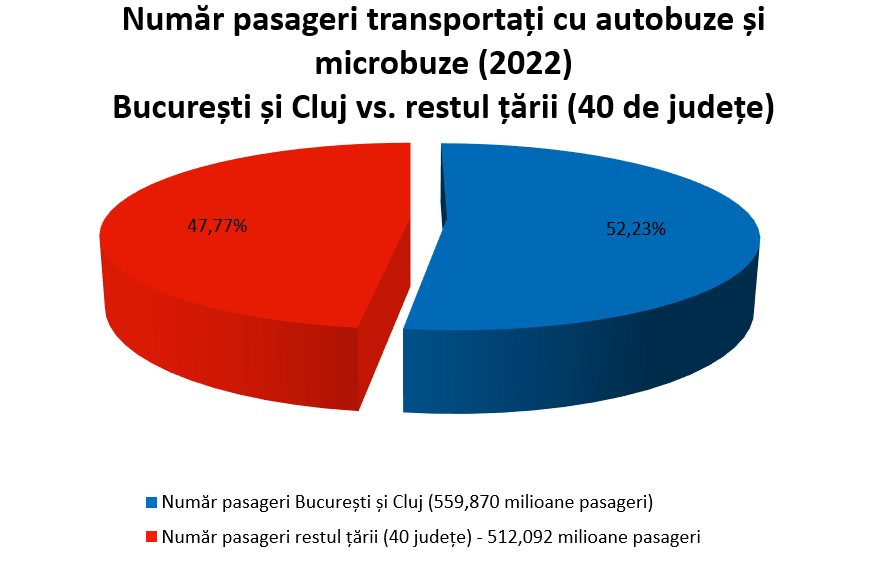
Public transport is an indicator of the degree/potential of community development, a standard of administrative efficiency and quality of public services offered to citizens.
In Mehedinci, there are more than 1,200 times fewer passengers in local public transport than in Cluj (in 2022).
Disparities in development between counties and regions are highlighted, in particular, in huge differences in the number of passengers using local public transport.
The most used types of passenger transport last year were buses and minibuses, which accounted for approximately 2/3 of transported passengers (excluding the metro).
OPERATION OF LOCAL PUBLIC TRANSPORT: BUCHAREST AND Cluj
Bucharest is a dedicated leader in terms of the number of passengers who used local public transport in 2022.
More than half of the travelers were registered in the capital.
Bucharest recorded more passengers using the metro (approximately 130 million) than the total number of passengers in any county except Cluj.
With 163.634 million passengers, Cluj is the only county to register more passengers than any other development region (except the Bucharest region).
Compared to the second-ranked county of Timișoara, Cluj had more than 63% more passengers on local transport, and compared to the third-ranked county of Iași, the number of passengers almost doubled.
The number of passengers who used local transport in Cluj was more than three times higher than in Dolj County.
Furthermore, Cluj is the only county (apart from Bucharest) to register more than 150 million travelers using local transport.
Of the 1.79 billion passengers who used local transport services, about 60% used buses and minibuses.
Bucharest and Cluj (with approximately 560 million passengers) carried more passengers by this mode of transport than all other countries combined (512 million passengers).
At the opposite pole of the performers of the local transport system are Kalarash, Harghita, Teleorman, Ilfov and Mehedinci, counties that registered several hundred thousand passengers in 2022 (605,000, Kalarash or only 136,000 passengers, Mehedinci).
Even Olt, Ialomica or Giurgiu are not doing much better, although they managed to break the bar of 1 million passengers per year.

ADDITIONAL SYSTEMS OF LOCAL PUBLIC TRANSPORT – TROLLEY BUS AND TRAM
In each county, buses (including minibuses) are part of the local passenger transport system.
Cluj, Ploiesti and Timișoara are the only settlements (with the exception of Bucharest) where local public transport was implemented in 2022 with three modes of transport (trams, buses and minibuses, trolleybuses).
Among the 41 counties, only eight counties provided local public transport with trams, as well as buses and minibuses (Cluj, Bihor, Iași, Braila, Prahova, Dolj, Arad and Timișoara).
Also, in eight counties, trolleybuses provided passenger transportation, as well as buses and minibuses (Cluj, Maramures, Brasov, Sibiu, Galati, Prahova, Gorz and Timis).
From the point of view of regional development and mode of transport:
- The north-west region (Cluj, Maramures, Bihor, Satu Mare, Bistrita Neseud and Salai) is the only region that has two counties in which local public transport is provided by buses and trams (Cluj and Bihor), respectively by buses and trolleybuses ( Cluj and Maramures).
- The North-West Region and the West Region (Timish, Arad, Karash-Severin, Hunedoara) are the only regions with two counties each in which local public transport was also provided by trams (except buses and minibuses) last year, respectively Cluj and Bihor, as well as Arad and Timișoara.
- While in the Central Region (Brasov, Sibiu, Mures, Alba, Covasna, Harghita) passengers could not travel by tram in any county.
- At the same time, the North-West Region and the Central Region are the only regions where travelers could use local trolleybuses in each county (Cluj and Maramures, Sibiu and Brasov, respectively).
- While in the North-East region (Iasi, Suceava, Vaslui, Bacau, Botosani, Neamts) in 2022, local transport did not include trolleybus lines in any county.
- The North-Eastern and South-Munten regions (Prahova, Arjes, Dambovitsa, Jalomitsa, Giurgiu, Kalaras, Teleorman) are the only regions in which local public transport was carried out by other means of transport in one district of the region. than buses and minibuses (Iasi, Prahova, respectively).
- South-Western Oltenia (Dolzh, Gorzh, Vilcha, Olt, Mehedyntsi) in 2022 recorded the lowest number of passengers who used public transport, namely 58.623 million passengers.
- The counties of Cluj, Timișoara, Iasi and Prahova had more passengers than the entire south-western region of Oltenia.
BALANCE AND UNBALANCE: TROLLEY vs. TRAM
Last year, the tram was the second most passenger transport vehicle with 432.558 million passengers.
And in this section, Bucharest is a clear leader, the number of passengers who used the tram is more than twice as large as in the rest of the country.
In the case of local public transport with trolleybuses, the situation was more balanced.
Of the 155.704 million passengers who used the trolleybus in 2022, Bucharest had a market share of 40.29%, Cluj – 26.21% and Timisoara – 16.38%, together representing 82.88% of the total number of passengers carried.
A big advantage of public transport with trolleybuses is that the new models can be equipped with rechargeable batteries and can travel certain distances without connecting to the contact network (and where the network allows, the batteries can be charged during the trip in trolleybus mode), which creates a competitive advantage in terms of reorganizing/diverting routes. Read the rest of the article on Contributors.ro
Source: Hot News
James Springer is a renowned author and opinion writer, known for his bold and thought-provoking articles on a wide range of topics. He currently works as a writer at 247 news reel, where he uses his unique voice and sharp wit to offer fresh perspectives on current events. His articles are widely read and shared and has earned him a reputation as a talented and insightful writer.